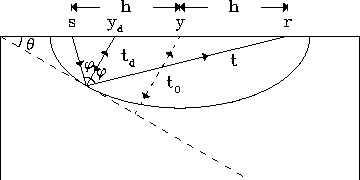




Next: NUMERICAL EXPERIMENTS
Up: Zhang: DMO
Previous: Introduction
Here I review the definitions of two DMO operators. The detailed
derivations are given earlier by Zhang (1988).
Let P(t,y,h) denote a constant offset section,
Pn(tn,y,h) the section after normal moveout (NMO) corrections,
and P0(t0,y,h) the section after the NMO and DMO corrections.
Figure ![[*]](http://sepwww.stanford.edu/latex2html/cross_ref_motif.gif) shows the coordinates of these sections.
shows the coordinates of these sections.
dmogeo
Figure 1 The geometry of the experiment: common mid-point versus common depth-point.

NMO correction is a time-stretching operation:
where t and tn are related by the normal moveout equation.
Hale relates the DMO-corrected section to the NMO-corrected section as follow:
|
P0(t0,y,h)=Pn(tn,y,h).
|
(2) |
From Figure ![[*]](http://sepwww.stanford.edu/latex2html/cross_ref_motif.gif) , it is clear
that the events represented by the two sides of equation (2)
are not reflected from the same depth point if the dip of the reflector is
nonzero. Therefore, the operator obtained from this relation may not preserve
the correct amplitudes of the reflected events.
To solve this problem, I define the DMO operation by explicitly relating
the events reflected from the common depth points, as follows:
, it is clear
that the events represented by the two sides of equation (2)
are not reflected from the same depth point if the dip of the reflector is
nonzero. Therefore, the operator obtained from this relation may not preserve
the correct amplitudes of the reflected events.
To solve this problem, I define the DMO operation by explicitly relating
the events reflected from the common depth points, as follows:
|
Pd(td,yd,h)=Pn(tn,y,h).
|
(3) |
From this definition, one would expect that the DMO operator would have
some desirable properties in its amplitude spectrum. And, indeed, as the next
section shows, this DMO operator has a
uniform amplitude spectrum with respect to dips and offsets.





Next: NUMERICAL EXPERIMENTS
Up: Zhang: DMO
Previous: Introduction
Stanford Exploration Project
12/18/1997
![[*]](http://sepwww.stanford.edu/latex2html/cross_ref_motif.gif) shows the coordinates of these sections.
shows the coordinates of these sections.
![[*]](http://sepwww.stanford.edu/latex2html/cross_ref_motif.gif) shows the coordinates of these sections.
shows the coordinates of these sections.

![[*]](http://sepwww.stanford.edu/latex2html/cross_ref_motif.gif) , it is clear
that the events represented by the two sides of equation (2)
are not reflected from the same depth point if the dip of the reflector is
nonzero. Therefore, the operator obtained from this relation may not preserve
the correct amplitudes of the reflected events.
To solve this problem, I define the DMO operation by explicitly relating
the events reflected from the common depth points, as follows:
, it is clear
that the events represented by the two sides of equation (2)
are not reflected from the same depth point if the dip of the reflector is
nonzero. Therefore, the operator obtained from this relation may not preserve
the correct amplitudes of the reflected events.
To solve this problem, I define the DMO operation by explicitly relating
the events reflected from the common depth points, as follows: